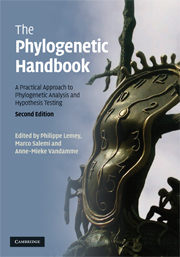Book contents
- Frontmatter
- Contents
- List of contributors
- Foreword
- Preface
- Section I Introduction
- Section II Data preparation
- Section III Phylogenetic inference
- Section IV Testing models and trees
- Section V Molecular adaptation
- Section VI Recombination
- Section VII Population genetics
- Section VIII Additional topics
- 20 Assessing substitution saturation with DAMBE
- 21 Split networks. A tool for exploring complex evolutionary relationships in molecular data
- Glossary
- References
- Index
21 - Split networks. A tool for exploring complex evolutionary relationships in molecular data
from Section VIII - Additional topics
Published online by Cambridge University Press: 05 June 2012
- Frontmatter
- Contents
- List of contributors
- Foreword
- Preface
- Section I Introduction
- Section II Data preparation
- Section III Phylogenetic inference
- Section IV Testing models and trees
- Section V Molecular adaptation
- Section VI Recombination
- Section VII Population genetics
- Section VIII Additional topics
- 20 Assessing substitution saturation with DAMBE
- 21 Split networks. A tool for exploring complex evolutionary relationships in molecular data
- Glossary
- References
- Index
Summary
THEORY
Understanding evolutionary relationships through networks
The standard way to represent evolutionary relationships between a given set of taxa is to use a bifurcating leaf-labeled tree, in which internal nodes represent hypothetical ancestors and leaves are labeled by present-day species (see Chapter 1). Using such a tree presumes that the underlying evolutionary processes are bifurcating. However, in instances where this is not the case, it is questionable whether a bifurcating tree is the best structure to represent phylogenetic relationships. For example, the phenomena of explosive evolutionary radiation, e.g. when an AIDS virus infects a healthy person, might be best modeled not by a bifurcating tree, but by a multifurcating tree (see Chapter 1). In addition, it may be necessary to label internal nodes by taxa if ancestors and present-day species co-exist, as has also been observed with fast evolving viruses.
In certain cases, one might want to allow even more general structures than multifurcating trees to represent evolutionary histories. For example, certain viruses/plants/bacteria are known to exhibit recombination/hybridization/gene transfer, and this process might not always be best represented by a tree. In particular, a tree implicitly assumes that once two lineages are created they subsequently never interact with one another later on. However, if it is assumed that such interactions might have occurred, then a simplistic representation of this might look something like the network (or labeled-graph) presented in Fig. 21.1.
Information
- Type
- Chapter
- Information
- The Phylogenetic HandbookA Practical Approach to Phylogenetic Analysis and Hypothesis Testing, pp. 631 - 653Publisher: Cambridge University PressPrint publication year: 2009
Accessibility standard: Unknown
Why this information is here
This section outlines the accessibility features of this content - including support for screen readers, full keyboard navigation and high-contrast display options. This may not be relevant for you.Accessibility Information
- 11
- Cited by
